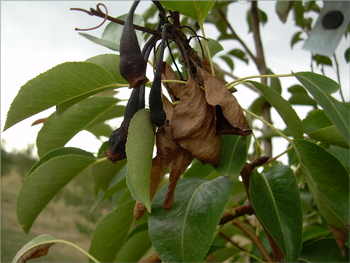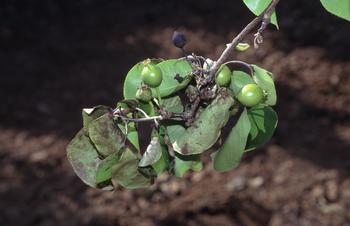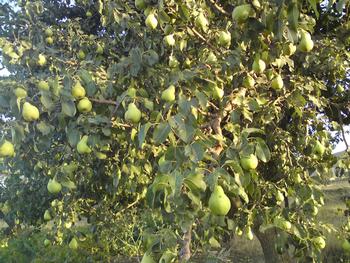Fire pear blight, what to look for, and how to control it
-
Martha Proctor
-
If you find sticky, amber-colored droplets on your pear tree, your tree could be infected with fire/pear blight, a bacterial disease caused by Erwinia amylovora. Unfortunately, this pathogen can invade all parts of a pear tree, causing wilt, eventual blackening, and ultimately death to shoots, flowers, and fruits. If the infectious parts of the tree are not removed, the entire tree may be killed as the disease spreads into the main branches, trunk, and roots. Erwinia amylovora affects 75 species of the rose family (Rosaceae) but is especially destructive to apples and pears.
 With fire pear blight, leaves wilt rapidly and turn dark but remain attached. Photo: Ninja Tacoshell wiki commons.
With fire pear blight, leaves wilt rapidly and turn dark but remain attached. Photo: Ninja Tacoshell wiki commons.Erwinia amylovora bacteria overwinter in cankers on branches and are spread by rain splash and insects attracted to the resultant bacterial ooze. In February, when pear trees blossom in Marin, if the weather is warm (temperatures over 65oF) and humid, bacteria begin to reproduce just as the pear’s pollinators (bees and flies) start to collect pollen from opening blossoms, spreading the infection. Symptoms in blossoms are first noted 1 to 2 weeks after petal fall. The flower becomes water soaked and assumes a dull, grayish-green appearance. Small droplets of initially creamy-white bacterial ooze (becoming amber-colored with age) form on water-soaked and discolored tissues. Shoot symptoms are similar to those in blossoms but develop faster. Leaves wilt rapidly, turn dark, and remain attached. At advanced stages, cracks develop in the bark.
Infections can occur throughout spring and summer. An infection’s ultimate severity primarily depends on the host species and its resistance to the disease. Also important are the environment, age, vigor, and nutritional status of the tree, as well as the amount of nitrogen fertilizer used and if the tree was heavily pruned or overly irrigated. Varieties of ornamental pear less susceptible to fire blight are Bradford, Capitol, and Red Spire; Aristocrat is highly susceptible. Asian and red pear varieties are very susceptible. Young, vigorous trees are more susceptible than older, slower-growing tissues or trees. Canker expansion slows in late summer as temperatures cool and the growth rate of trees and shoots declines. Fire Blight affecting tree leaves and branches. Photo: Jack Kelly Clark, courtesy University of California Statewide IPM Program
Fire Blight affecting tree leaves and branches. Photo: Jack Kelly Clark, courtesy University of California Statewide IPM ProgramEffective management of pear blight is mostly preventative, e.g., growing a resistant variety and maintaining good sanitation and cultural practices. Chemical sprays are not recommended for home gardeners. Instead, it is critical to monitor trees closely, especially in the years with warm, wet Februarys, and to quickly prune out infected parts, carefully disinfecting the pruning shears with each cut. In summer, when the chance of infection is less severe, trees can be pruned again to remove infected plant parts and overwintering cankers. Cultural practices that slow the rate of canker development include limiting irrigation and the use of nitrogen fertilizers and controlling insects attracted to the bacterial ooze, e.g., aphids, ants, bees, beetles, and flies.
All infected tree parts must be removed and destroyed by cutting at least 8 to 12 inches below the visible injury. This helps stop disease movement in the tree and reduces the source of new infections. In addition, it is critically important that any pruning shears and saws be sanitized with a 1:10 dilution of chlorine bleach or Lysol in water whenever they come into direct contact with diseased tissues. Pears grow well in many parts of Marin County. Photo: Al Borzagros
Pears grow well in many parts of Marin County. Photo: Al BorzagrosErwinia amylovora, the first bacteria shown to be a pathogen of plants in 1846, is still causing havoc on apple and pear trees today. Even 176 years later, no cure for this disease has been found. The preventative measures mentioned above are the best way the home gardener can manage this disease. Pear blight is just one of the many diseases which affect pear trees. The best advice is not to plant pear trees in Marin. If you have a pear tree, monitor the tree closely to see if the disease develops and prune out any diseased tissue as described above, carefully disinfecting your pruning shears with each cut. Sadly, with global warming and the increase in temperatures, it’s likely that fire blight will eventually preclude growing pears in Marin.



